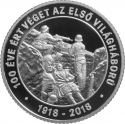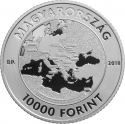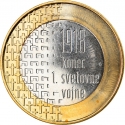You are about to finish your registration. Please check your mailbox (including spam folder). There should be a letter with a confirmation link. Check setting to make sure that your e-mail address is correct.
Send letter againDescription
More than four million American families sent their sons and daughters to serve in uniform during the Great War. 116,516 U.S. soldiers gave their lives in combat. Another 200,000 were wounded, a casualty rate far greater than in World War II.
The first American troops arrived in France in June. Through voluntary registration and the newly-formed draft, the American forces grew to approximately 500,000 soldiers by the end of summer.
In total, approximately 4 million men and women of the United States served in uniform, 2 million of whom were deployed overseas. Their heroic efforts in battles like the Battle of Belleau Wood, the Second Battle of the Marne, and the Meuse-Argonne Offensive helped turn the tide of the war, and ultimately led to the victory of the Allied Troops.
Engraver: Don Everhart (DE)
Designer: LeRoy Transfield (LCT)
Obverse
_Dollar_1/World_War_I_Centennial_2018_06.01.2018_15.28-60.jpg)
|
The obverse design, titled “Soldier's Charge,” depicts an almost stone-like soldier gripping a rifle. Barbed wire twines in the lower right-hand side of the design. LIBERTY |
|---|---|
Reverse
_Dollar_1/World_War_I_Centennial_2018_06.01.2018_15.28_01-60.jpg)
|
The reverse design is called “Poppies in the Wire.” Poppies are amid lines of barbed wire. Poppies have served as a means of remembering those who died fighting for their countries for nearly a century. The story originated with Lt. Col. John McCrae’s poem “In Flanders Fields,” which he composed shortly after losing a close friend. He wrote about the poppies because they were among the only things that could grow in the barren, war-trodden fields. Inspired by the poem, Moina Michael, an American academic, made and sold red silk poppies in 1921. Anna Guerin brought them to England, where the Royal British Legion ordered 9 million of them. The symbols of life, beauty, and remembrance are in stark contrast to the barbed wire, which caused countless deaths in the brutal trench warfare of World War I. ONE DOLLAR |
| Edge |
Related coins
100th Anniversary of the End of the First World War
100th Anniversary of the End of the First World War
100th Anniversary of the End of the First World War
_Dollar_1/World_War_I_Centennial_2018_06.01.2018_15.28.jpg)
_Dollar_1/World_War_I_Centennial_2018_06.01.2018_15.28_01.jpg)





